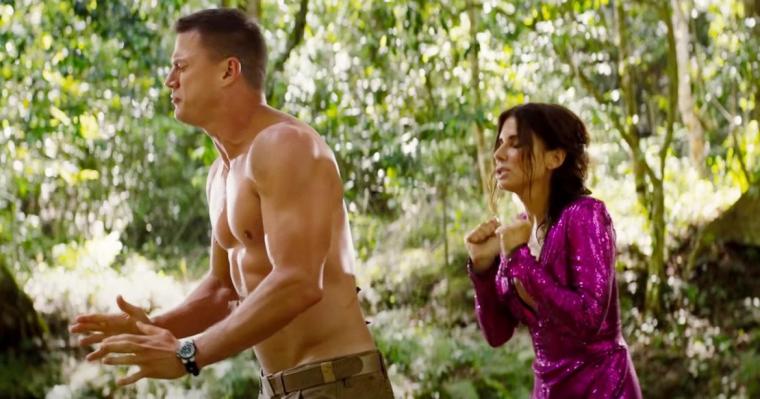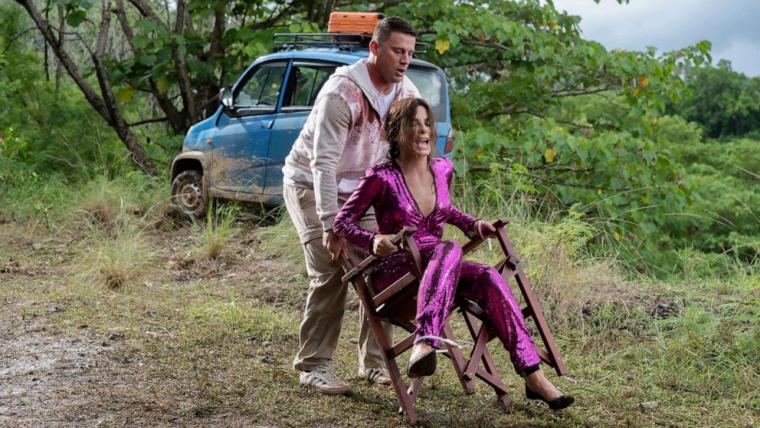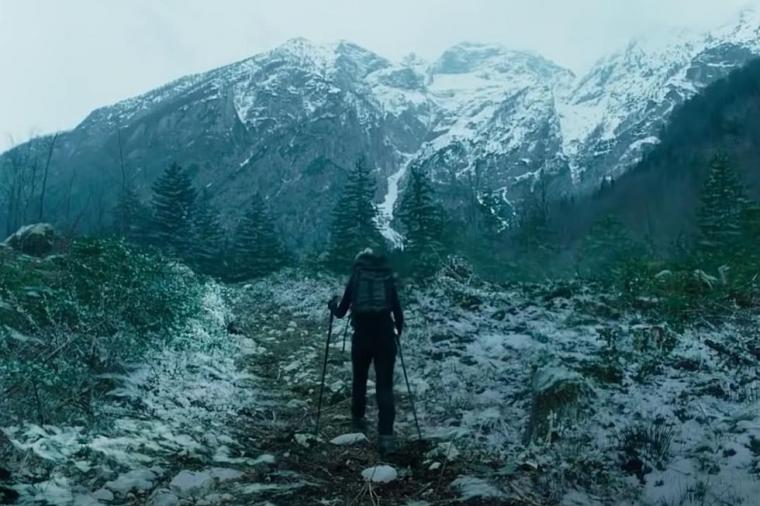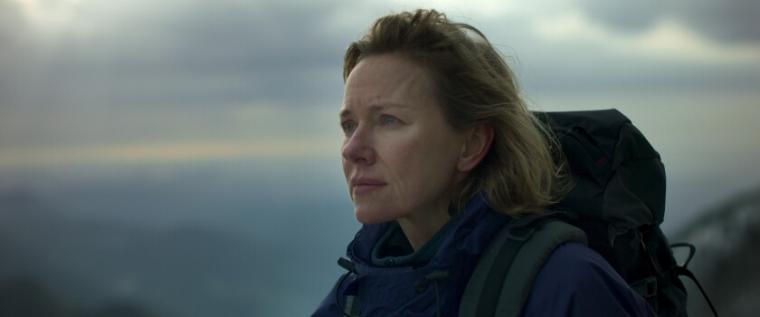
Channing Tatum and Sandra Bullock in The Lost City
THE LOST CITY
Sometimes getting exactly what you expect is exactly what you need. That, of course, seems self-evident. But it's less so when a movie's trailers promise a particular experience – say, Sandra Bullock and Channing Tatum quipping and slapstick-ing and sharing romantic chemistry in the jungle – and the movie itself doesn't bother giving you anything beyond the expected: no inventive narrative developments; no unanticipated grace notes; no surprise.
Consequently, the highest compliment I can pay directors Adam and Arron Nee's The Lost City is to say that the siblings' profoundly derivative adventure comedy did, on more than a few occasions, take me by surprise. At heart, just like its previews suggested, the film is nothing more than a modernized take on Robert Zemeckis' 1984 hit Romancing the Stone – “modernized,” in this case, meaning that the female lead is a decade-plus older than the male lead, and that a woman of color has a significant supporting role. But while I probably would've been perfectly content to watch Bullock and Tatum working at maximum-charm offensive in a wholly predictable throwaway entertainment, Team Nee proves itself to be more adventurous than expected (with Oren Uziel and Dana Fox completing the directors' quartet of co-screenwriters). The plotting is coloring-book simple … until a late-in-the-game twist reveals our heroes' central quest to be less mercenary than disarmingly sweet. The second bananas are expectedly banana-flavored … until a few of them are briefly, delightfully, allowed to take over the movie entirely. And with all due respect to Zemeckis' funny/exciting achievement, which I have adored ever since mid-puberty, Romancing the Stone didn't have Brad Pitt in it. The Lost City may be repackaged goods, but those goods, at least this time around, are still remarkably fresh.
I'm not sure what there is to say about the storyline that isn't apparent on the film's poster. But in case you need a synopsis: Bullcok plays Loretta Sage, a financially successful romance novelist and ancient-history whiz who feels she's reached the end of her professional inspiration. Tatum plays Alan Caprison, her paperbacks' seemingly dimwitted cover model who wants their P.R. ride to go on forever. While on an international book tour, Loretta gets kidnapped. Alan, feeling undervalued and emasculated (though he could never spell those words), decides to rescue her. And from there on, The Lost City finds room for Daniel Radcliffe as a megalomaniacal billionaire who demands that Loretta locate a hidden city of riches; Da'vine Joy Randolph as Loretta's perpetually exhausted agent; loads of Stone-y (and Indiana Jones-y) tombs and snakes and easily disposable henchman; and Pitt as a super-heroic wellness trainer conveniently named Jack Trainer. All of it is as silly and formulaic and easily disposable as they come. I had a ball at this thing.
Just because a movie is a great time, of course, doesn't mean it's a great movie, and I'm hardly blind to The Lost City's significant flaws. The Lee brothers' compositions and timing of physical gags, most of them dishearteningly bland, are hardly a match for Zemeckis' staging and Oscar-nominated editing (though the filmmakers do pull off a nice bit in which the sight of Loretta and Alan in a hammock mirrors the cover of one of Loretta's books). Despite Bullock's game performance, the blockbuster-requisite sentimentality surrounding our heroine's dawning happiness is blueprint-familiar to the point of tedium. And the movie doesn't play fair with Tatum's Alan, whom we're initially meant to feel superior to for his unrelenting dim-wittedness, and then expected to feel for when, out of the blue, Alan proves nowhere near as stupid as the movie's first hour demonstrated. (This is an age-old, endlessly irritating Hollywood trick: prompting audiences to laugh at a character for a long while before inevitably chiding us for our laughter.) That the Lees' movie still works is testament to the insane likability and charisma of its stars. That their movie works so joyfully well is testament to the stuff surrounding them.

At this point in their respective comedic careers, Bullock can play type-A neurotic and Tatum can play boneheaded sweetheart in their sleep. And while I didn't exactly feel much romantic chemistry between them, the performers do seem – especially in their more sincere moments – like they really enjoy each others' company, particularly when you sense that their byplay was at least partially improvised. (Loretta and Alan have an especially funny extended bit after accidentally killing a pair of goons, attempting to relieve their guilt by assuring themselves that the henchmen deserved to die: “Don't be mean. Don't be mean on a bike.”)
Yet while the exceptionally charming Bullock and Tatum are consistently giving you what you expect and want, a whole lot of others are providing what you didn't even know you wanted. We're routinely treated to momentary diversions such as Randolph' honest, hysterical account of what her agent definitively wants after a year-and-a-half without a nap. And Bowen Yang's book-talk moderator unable to mask his disappointment over a P.R. stop gone horribly wrong. And Patti Harrison as a social-media consultant eventually reduced to reading purple prose to her boss' blind grandmother. And The Office's Oscar Nuñez playing a flirty pilot whose best friend is a goat. And Radcliffe as the nominal villain whose funniest lines – and he's got a lot of funny lines – are weirdly tossed aside by the filmmakers … though I did relish Randolph's agent telling Loretta that upon meeting him, “I thought he was a little boy – but he had a full beard!”
Best of all among The Lost City's cinematic bon bons is Brad Pitt, whose cerebral adventurer Jack Trainer shows up earlier than expected, sticks around for less time than expected, and is granted about 30 seconds with Loretta – to Alan's hilarious displeasure – that make you antsy for a future feature-length comedy starring these two fabulous titans of '90s cinema who appear nowhere close to slowing down in the 2020s. My mother (who, Bullock and Tatum fan that she is, actually saw the movie the night before I did) revealed that a post-credits scene delivered hope for a Lost City sequel, with Pitt absolutely in attendance. As we all know, sequels oftentimes suck. If, however, there's the possibility of one that gets both me and my octogenarian mom equally psyched, by all means, bring it on.

INFINITE STORM
A survival drama by Polish director Malgorzata Szumowska, and one that tells 2010's true story of a grieving mountain climber and rescue volunteer who saved a despondent young man from certain death on New Hampshire's Mount Washington, Infinite Storm is the type of movie I'd never want to be in. So much snow! So much cold! So many precipitous heights! It's also the type of movie, generally speaking, that I never want to watch. (Did I mention the snow and cold and precipitous heights?) But Szumowska's riveting salute to the heroic Pam Bates – played with sensational force and determinism by Naomi Watts – is a film I'd be happy to watch a second and third time, and not merely because the half-hour that follows Bates' successful saving of an unidentified man she calls “John” is even better than the tension-filled, clinically documented hour-plus that precedes it.
With Michal Englert cited as Infinite Storm's co-director, Szumowska's frequently harrowing adventure is based on author Ty Gagne's magazine article “High Places: Footprints in the Snow Lead to an Emotional Rescue.” That probably would've been a tad too on-the-nose for a movie title. And it certainly would've given away the surprise for audiences wondering whether Watts' ultra-prepared Pam would actually prevail in her unanticipated mission after encountering her nameless charge (Billy Howle): a guy who, astoundingly, she finds sitting in the arctic weather on the edge of a cliff dressed in cargo shorts and sneakers. (“Sneakers?” Bates asks herself when first seeing those footprints. “What the f---?”) But it turns out that the design for Josh Rollins' screenplay has surprisingly little to do with the rescue itself.
Yes, the pair's significant hardships on the road back to civilization take up a majority of the film's length, and we witness this specific genre's requisite beats: the tending to frostbite and injured limbs and extremities; the frightening tumble down a hill after someone makes one wrong step; “John” falling into a rushing river even after Pam begs him to please please not fall into the rushing river. (The film's most alternately frustrating and refreshing aspect is that “John,” as Pam has no trouble expressing, is an absolute pain in the ass; battling both the elements and this man's seemingly drugged-out petulance, it's like Pam has a 180-pound toddler strapped to her back.) When the survivors ultimately make it back to their cars safely, however, we're only about 70 minutes into the picture, and what follows is what Infinite Storm is really about: the after-effects of living through – of choosing to live through – unimaginable fear and tragedy. Imagine Captain Phillips' final 10 minutes stretched out to 30, and you'll get the basic idea.

We're prepped for the movie's emotional urgency fairly early on, not only in Pam's loaded conversation with a friendly café proprietor (the ever-appreciated Denis O'Hare), but in the images of the woman's no-longer-present five- and six-year-old daughters viewed in a photograph and witnessed in flashback after Pam suffers a potentially fatal accident on her annual trek up Mount Washington. (Although the situation suggests it, Infinite Storm blessedly never turns into 127 Hours.) Yet instead of feeling employed as backstory filler á la Gravity or Robin Wright's Land, Pam's trauma is more akin to the loss endured by Amy Adams' scientist in Arrival: trauma that doesn't feel manipulatively tacked on, but rather essential to the drama. With hints about Pam's mental state cleverly interwoven throughout, Szumowska's offering is terrific in what it shows, but even more effective in detailing what it means, and it's hard to recall a recent movie that so fully deserved a half-hour-long coda.
Always at her finest when playing characters at their emotional extremes, Watts may never give a performance to match her thunderous 2001 breakout in David Lynch's Mulholland Dr. But I'm happy to cite her work here as a close runner-up. Watts' portrayal is marvelously unfussy and direct, allowing for lovely and humorous asides (I truly appreciated how badly Pam sung along to the car radio), and she's utterly devastating when her heroic figure – like Tom Hanks' ship captain demonstrating his PTSD – eventually falls apart, laughing and crying in front of an open fridge while chugging beers and devouring leftover pizza. Whenever her roles allow it, Watts can be the most spectacularly anti-glamorous of modern movie stars (though certain fans will be delighted to learn that the 53-year-old can still pull off a full nude scene with enviable aplomb), and her tortured commitment is eventually almost matched by the heartbreaking work of Howle, whose dead-weight lug is revealed to be suffering, internally, just as much as Pam. I welled up when, on that mountain, Pam and “John” finally shared a laugh about their mutually horrific situation. I welled up again when, during the film's subdued short-film-length climax, they finally shared what their collective experience was truly about. Infinite Storm is an occasionally grueling sit. The scenes that hurt the most in this survival drama, though – in the most satisfying way – aren't at all the survival-drama scenes you expect.










